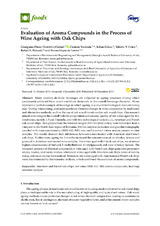Mostrar el registro sencillo del ítem
Evaluation of Aroma Compounds in the Process of Wine Ageing with Oak Chips
| dc.contributor.author | Dumitriu, Georgina-Diana | |
| dc.contributor.author | Teodosiu, Carmen | |
| dc.contributor.author | Gabur, Iulian | |
| dc.contributor.author | Cotea, Valeriu V. | |
| dc.contributor.author | Peinado Amores, Rafael | |
| dc.contributor.author | López de Lerma Extremera, M. Nieves | |
| dc.date.accessioned | 2019-12-10T10:05:27Z | |
| dc.date.available | 2019-12-10T10:05:27Z | |
| dc.date.issued | 2019 | |
| dc.identifier.uri | http://hdl.handle.net/10396/19186 | |
| dc.description.abstract | Many modern alcoholic beverages are subjected to ageing processes during which compounds extracted from wood contribute decisively to the overall beverage character. Wines represent a perfect example of beverage in which ageing is a crucial technological manufacturing step. During winemaking, producers accelerate chemical changes in wine composition by traditional and alternative methods, such as the use of oak wood barrels and/or oak wood chips. Our research aimed to investigate the overall volatile composition and sensory quality of red wines aged for two timeframes, namely, 1.5 and 3 months, and with two technological variants, i.e., American and French oak wood chips. Red grapes from the Fetească neagră (Vitis vinifera) variety were harvested from a vineyard in the North-East region of Romania. Stir bar sorptive extraction and gas chromatography coupled with mass spectrometry (SBSE–GC–MS) was used to extract minor aromas present in wine samples. The results showed clear differences between wines treated with American and French oak chips. Furthermore, ageing for 3 months increased the concentration of cis-whiskey lactone and guaiacol in American oak-treated wine samples. For wines aged with French oak chips, we observed higher concentrations of furfural, 5-methylfurfural, 4-vinylguaiacol, and trans-whiskey lactone. The increased presence of chemical compounds in wine aged with French oak chips generated prominent smoky, licorice, and toasty aromas, whereas in wines aged with American oak chips, notes of vanilla, toasty, and cacao aromas were noticed. Moreover, red wines aged with American and French oak chips were discriminated by chemometric analysis, which confirmed the evolution of aroma compounds. | es_ES |
| dc.format.mimetype | application/pdf | es_ES |
| dc.language.iso | eng | es_ES |
| dc.publisher | MDPI | es_ES |
| dc.rights | https://creativecommons.org/licenses/by/4.0/ | es_ES |
| dc.source | Foods 8(12), 662 (2019) | es_ES |
| dc.subject | American and French oak chips | es_ES |
| dc.subject | Red wine | es_ES |
| dc.subject | SBSE–GC–MS | es_ES |
| dc.subject | Aroma compounds | es_ES |
| dc.subject | Heatmap | es_ES |
| dc.subject | Sensorial analysis | es_ES |
| dc.title | Evaluation of Aroma Compounds in the Process of Wine Ageing with Oak Chips | es_ES |
| dc.type | info:eu-repo/semantics/article | es_ES |
| dc.relation.publisherversion | http://dx.doi.org/10.3390/foods8120662 | es_ES |
| dc.relation.projectID | Gobierno de España. PN-III-P1-1.1-PD-2016-0325 | es_ES |
| dc.rights.accessRights | info:eu-repo/semantics/openAccess | es_ES |

